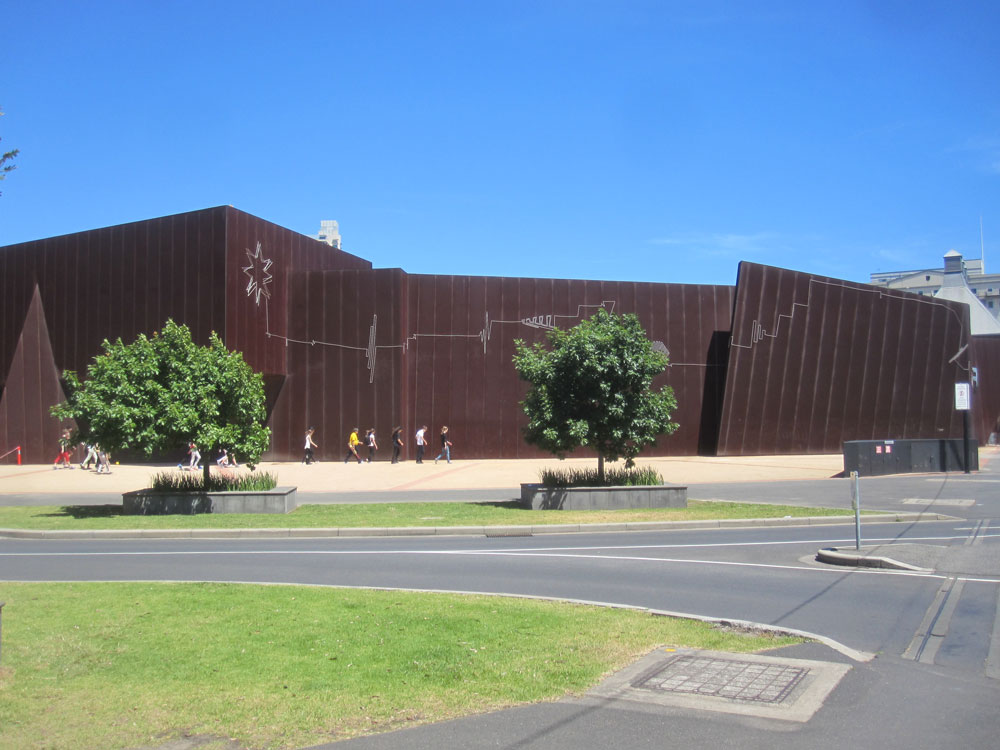Via Ferrata (ACCA)
2012
Site specific drawing installation.
250m rope and magnets on steel building.
ACCA, Melbourne, Australia.




Via Ferrata's began as part of the war machine (WW1) developed to prosecute and defend a war frontier (the mountain war in the Dolomites) - the frontiers that later crystallised the borders of European states. Essentially Via Ferrata's (meaning 'iron way') were steel cables and stemples installed as a means to ascess strategic summits. In this they are implicitly connected to the 'modern' nation state, international borders and the creation of those bounded identities. Their contemporary status now carries a weird potential with that history - as the boundaries and solidilty of that history loses coherence and mutates to new forms and understandings. Today they offer access to a humbling personal and social recreation - a place of jeopardy, fun, beauty and transformation - layered over a material and cultural history that in places acts as a museum history. Amazingly they also channel lightening strikes and audio waves from the summit skies down to the valleys - like some strange form of atmospheric communication.
Via Ferrata (ACCA) is a rope drawing - made insitu climbing and descending the Coreten clad ACCA building. The rope is attached by magnets placed to maintain and shape the position of the route.
Here the drawn line develops the Via Ferrata concept - exploring the idea of the mountain wires as both a linear drawn line and also apparatus of borders, states and nationhood where the line forms a shape or body. In one sense the line is a space in itself - as it carries a tragectory - a temporal space - a period of time from the start to finish or between any one point and another. This 'space' seems fractal in that it opens up on itself combining the lived experience of the creative act with the record of it's own making. This is in a connected tension with the shapes and forms the lines bound, close around or suggests - not least the top and bottom of the wall. In this sense it connects with Paul Klee's description of drawing - taking a line for a walk (or climb) which acknowledges the sequential 'linear' act of drawing and the consequential forming of a gestalt 'thing'.
ACCA Time Lapse (music and edit by Emma Sulivan/ACCA):
ACCA Interview:(edit by Emma Sulivan/ACCA)
Feature / reviews:
The AGE newspaper 11/12/2012:
http://www.theage.com.au/entertainment/art-and-design/artist-with-a-higher-calling-shows-acca-the-ropes-20121211-2b7n2.html
Shown at:
Desire Lines. ACCA, Melbourne Australia. 2012. Solo commission and group show. Curated by Juliana Engberg.
Desire Lines will also feature several key performances, including
• British artist Dan Shipsides will create one of his renowned climbing based artworks on the exterior of the ACCA building.
Desire Lines exhibiting artists:
Francis Alÿs, Samuel Beckett, Pierre Bismuth, Marcel Broodthaers, Mircea Cantor, A K Dolven, Jacqueline Donachie, Willie Doherty, Tacita Dean, Rodney Graham, Joan Jonas, Leopold Kessler, Eva Koch, Jochen Kuhn, Rachel Lowe, Richard Long, David Link, Todd McMillan, Bruce Nauman, Mel O’Callaghan, Paulien Oltheten, Yvonne Rainer, Dan Shipsides, Shipsides and Beggs Projects, Charlie Sofo, Grant Stevens, Stephen Sutcliffe, Robert Smithson, Lawrence Weiner, Catherine Yass, and Akram Zaatari.
Other Dan Shipsides / Shipsides and Beggs Projects artwork shown in Desire Lines:
 Capella Head Point (series A). White ink on lambda photo prints.
Capella Head Point (series A). White ink on lambda photo prints.
 BIVACCO - 2011 (HD video 21min)
BIVACCO - 2011 (HD video 21min)











